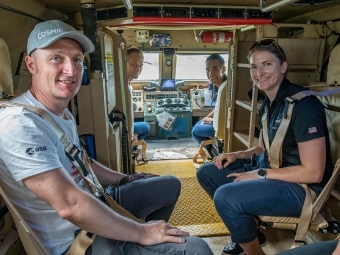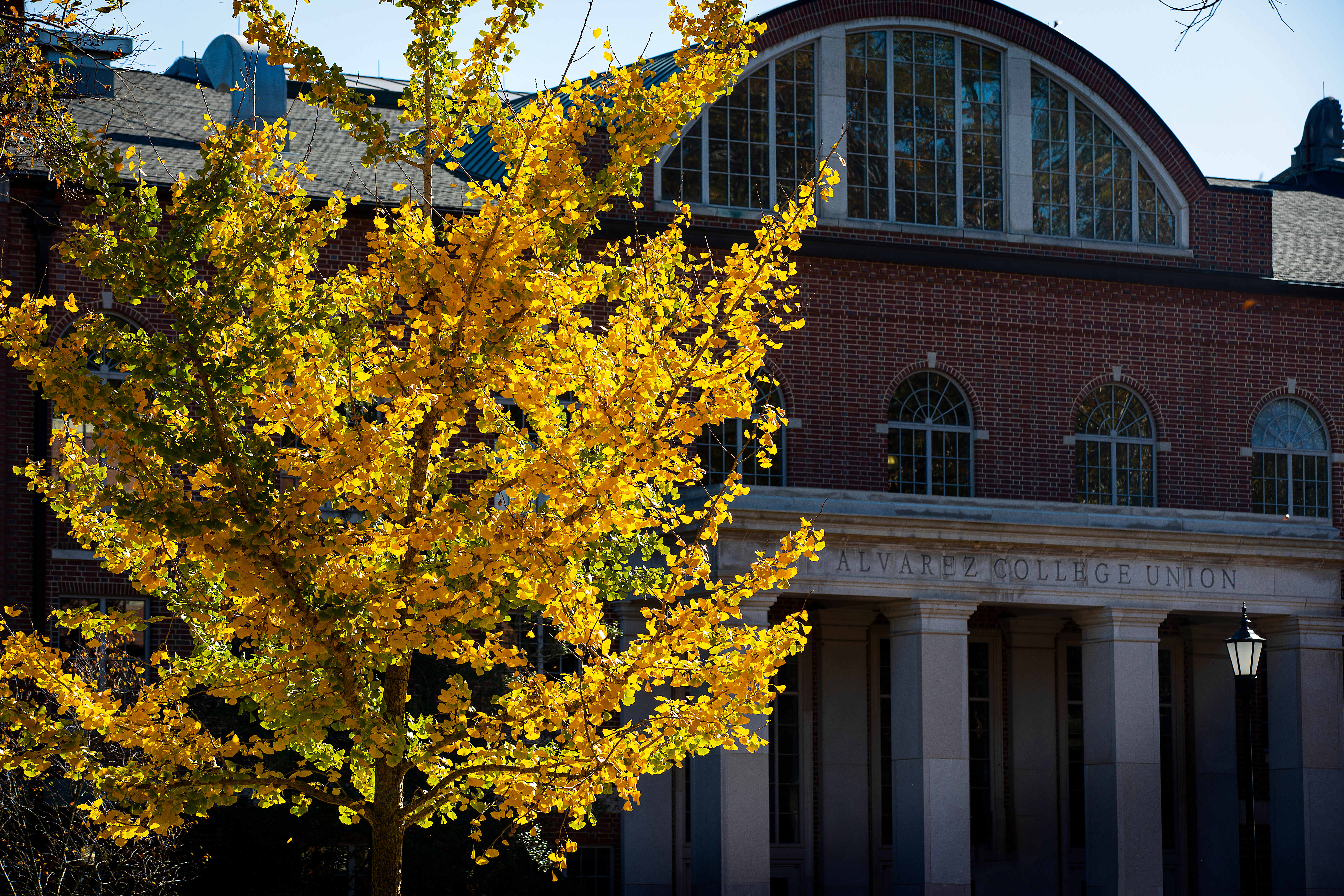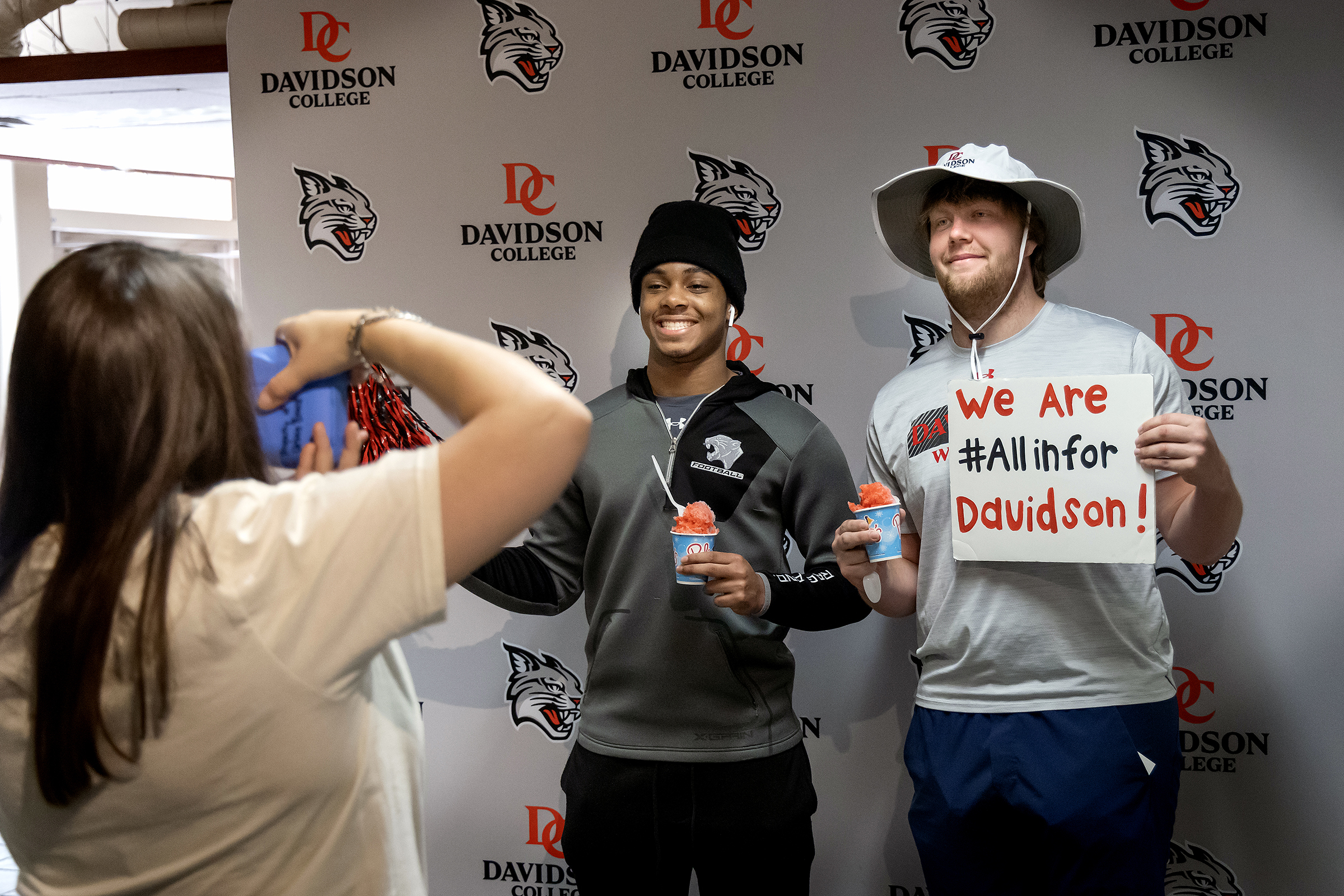No Gravity, No Dysfunction: Astronauts Bring Different Strengths to Crew ‘Family’
October 13, 2021
- Author
- Mark Johnson

The astronauts of SpaceX Crew-3 pose for a portrait in their suits during a training session inside the SpaceX Crew Dragon spacecraft. From left are, ESA (European Space Agency) astronaut Matthias Maurer and NASA astronauts Raja Chari, Thomas Marshburn ’82 and Kayla Barron. Chari is commander, Marshburn is the pilot and Barron and Maurer are both mission specialists. Credit: SpaceX
Spacewalking astronauts hook on to the International Space Station with tethers to keep from floating away, but the lifelines themselves pose a danger. The astronauts, already hampered by their bulky suits, must manipulate both a safety line and a shorter tether to anchor and work in one spot.
A wrong twist or turn and they’re caught in the tether rather than protected by it.
“You can end up in a total mess, if you’re not careful,” said Kayla Barron, a U.S. Navy officer, nuclear engineer and member of the third NASA crew scheduled to fly a SpaceX Crew Dragon capsule to the International Space Station later this month.
She is slated to launch along with three crewmates, including Davidson College alum Tom Marshburn.
NASA crews mix a range of personalities, careers, perspectives, nationalities, and eccentricities to live and work in tight quarters, and in a place where humans are not supposed to live.
To weave them together takes weeks and, along the way, helps solve problems like the spacewalk tether.
Barron practiced spacewalking in recent months in the neutral buoyancy lab at Johnson Space Center, in Houston. The pool’s 6.2 million gallons of water help simulate weightlessness. For one of these events, she was paired with crewmate Matthias Maurer, a German astronaut from the European Space Agency. Maurer, a former emergency medical technician, is a materials scientist, an expert in understanding the molecular structure and properties of different materials. He holds five international patents and five in Germany.
“Matthias thinks differently than anyone I have worked with at NASA,” Barron said. “He usually has one or two ideas that the other crewmembers and our [training] instructors have never thought of doing.”
The pair practiced rescuing each other on a spacewalk. If something goes wrong with a spacesuit or an astronaut has a medical problem, the other astronaut must wrangle two sets of tethers and get them both back to the airlock, fast. Barron called it “the hardest of the hardest.”
“[Maurer] had all of these ideas on how to manage tethers that were more efficient for him,” Barron said, “and a little different from what I do and what other astronauts I’ve trained with do. He often has ideas that we each incorporate into our own approach.”
Diverse Experiences, Perspectives
Barron is a submarine officer, in addition to an engineer. Marshburn is a physician, and Raja Chari, commander in the Crew Dragon, is an U.S. Air Force colonel and test pilot—call sign “Grinder”—who was among the first to fly the new F-35 stealth fighter.
The crew’s mix of military, physical science, medical science and engineering expertise gets at how things work, why they work and how to make them work.
“All crews are like families,” Marshburn said, “but usually very functional families. We’re putting people together with different quirks and skill levels. The mix of military pilots and scientists is probably the biggest professional difference in any crew.”
Michael Collins, who piloted the command module for Apollo 11, referred to himself and moonwalkers Neil Armstrong and Buzz Aldrin as “amiable strangers.”

SpaceX Crew-3 astronauts (from left) Thomas Marshburn, Matthias Maurer, Kayla Barron and Raja Chari are pictured during preflight training at NASA's Kennedy Space Center in Florida. Credit: SpaceX
Barron said, “you start to suss out everybody’s unique perspective and approach.”
NASA crews spend months in training, an experience that helps build the relationships.
Chari is commander of the Crew Dragon, and Marshburn is the pilot. When everything is normal, Barron and Maurer have monitoring duties. In an emergency, they step in to back up Chari and Marshburn, who will zero in on the problem.
They learn more about each other than duties.
The crew and their families had dinner together at Marshburn’s house. When they fly from Houston to Florida in T-38 jets, Marshburn rides with Chari, and they talk about their families along the way. The crew gets to understand each other’s styles and habits. Usually, Chari flies the takeoff and landing, and Marshburn takes the stick during the trip. On one flight, Chari spotted a possible encounter with a flock of birds and took control.
Barron said Chari is the best at breaking old work habits to adapt to the space mission.
Chari knows that Marshburn’s voice gets quieter when he’s thinking out loud.
And Barron noticed that Marshburn tends to ask questions first.
“He’s a really good listener,” Barron said. “Before he shares his own view, he’s really careful to see what we think. He seems aware that, because he has the most experience, we might tend to fall in line with what he says.”
The crew collaborated to name their capsule—“Endurance.” Chari explained during the crew press conference that the name is a tribute to the tenacity of human spirit and the resilient work of the support teams during the pandemic, as well as a nod to the early Antarctic expedition on a ship of the same name.
Once aboard the ISS, Marshburn will become commander, as the veteran on his third trip. Chari, Barron and Maurer all are making their first flights.
Marshburn said he thinks every day about how to make sure the crew syncs. He wants to stay out of the way where each crew member excels and help fill in the gaps needed to empower them.
The crew, in a way, functions like the spacewalk tether. They serve as each other’s lifeline and learn enough about each other to avoid getting tangled up.
Related Stories
This is the fourth in a series of reports astronaut Tom Marshburn ’82 will share with Davidson.edu readers as he prepares for his third trip to the International Space Station.



